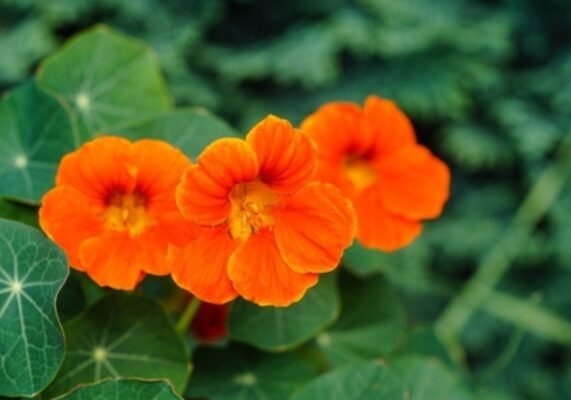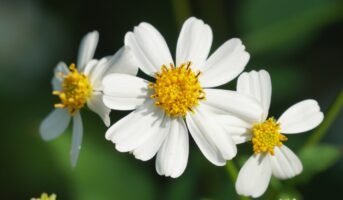Warm-weather annual Tropaeolum majus, commonly known as garden nasturtium, has tall stems, parasol-like leaves, and spurred 5-petal blooms. Indian cress, or Tropaeolum majus, is well-liked in many different kinds of gardening. It is available in bushy and climbing varieties. The bushy dwarf varieties are between 12″ and 2′ broad.
For beds, borders, ground coverings, rock gardens, or other large-scale plantings, those are fantastic options. The 10′ tall climbing varieties may swiftly cover banks, trellises, and fences.
The Greek term tropaion, which means trophy, and the Latin word tropaeum, which Linnaeus called for its similarity to a classical trophy, are the sources of the genus name.
Source: Pinterest
Tropaeolum majus: Facts
| Common Names | Garden nasturtium, Indian cress, nasturtium, tall nasturtium |
| Family | Tropaeolaceae |
| Origin | South America |
| Height | Upto 10 feet tall |
| Flowering | May / June to October |
| Genus | Tropaeolum |
| Plant type | Annual, perennial |
| Sun exposure | Full |
Tropaeolum majus: Characteristics
- It is a short-lived herbaceous plant with fleshy, creeping, or spreading stems.
- The margins of its spherical leaves (4–15 cm broad) are whole or barely lobed.
- The undersides of these leaves have long stalks attached in the middle that carry the leaves.
- Its large orange, yellow, or red flowers are 2.5-7 cm in diameter and have a long, narrow spur at the base that is 2.5–4 cm long.
- It’s 10 mm long, meaty, light green fruit is divided into three ribbed “seeds.”
Tropaeolum majus: Is it an indoor plant?
Due to their tenacity, toughness, and ability to adapt to adverse environments, nasturtiums will flourish in a range of circumstances. They thrive just as well in little rock gardens, hanging baskets, urban window boxes, courtyard gardens, and wide beds and borders. They even grow under trees, producing living carpets that effectively fend off weeds. Additionally, these plants are non-toxic, so you don’t need to worry if you have pets at home.
Tropaeolum majus: How to grow
- Once all threat of frost has passed, sow seeds in the garden in late spring to early summer, or start indoors in peat pots four to six weeks before the typical last frost date.
- Seeds should be sown 10–12″ apart, 1/2” deep (because they need darkness to germinate). To increase germination, soak the seed overnight. Depending on the temperature of the soil, they should emerge in a week to ten days.
- Except in extremely poor soil, avoid fertilising because it will encourage leaf growth and suppress flowering.
- Picking or deadheading the flowers will extend blooming. Till the first frost, the nasturtium will continue to blossom.
- Water them throughout the entire growing season to keep them blooming even though they prefer dry soil and can withstand drought.
Tropaeolum majus: Care tips
Light requirements
Nasturtiums grow and bloom best in full sun, receiving six to eight hours of direct sunlight per day. Although it can survive in partial shade, this plant might not produce as many flowers. However, given that hot temperatures can induce leaf browning, some shade is really preferable in warm climates.
Soil requirements
Surprisingly, nasturtium flowers thrive in relatively infertile soil with adequate drainage. Overly rich soil produces a lot of greenery but few flowers. This plant grows best in soil with a neutral pH (6 to 8) and can tolerate dry conditions, though it prefers moderate moisture.
Water requirements
Nasturtiums prefer weekly watering, but can be watered more frequently if grown in a greenhouse or a sunny vegetable plot. Nasturtiums can withstand moderate droughts, but their blooms will likely fade, and their foliage will become spindly.
Source: Pinterest
Tropaeolum majus: Uses
Ornamental
When it comes to gardens of all shapes and sizes, nasturtiums, which are bouncing, tireless stalwarts, check a lot of the right boxes whether you view them as attractive flowers, inventive herbs, or easygoing ground cover.
Their abundant displays break forth with lovely colour, tumbling from pots and crowded borders, scrambling over trellises or anchoring boulder flower beds. They are edible and beautifully alluring.
Medicinal
Tropaeolum majus has medicinal uses as well. It is used for healing chest colds, aids in the formation of new blood cells, gets rid of urinary tract infections, as an antiseptic, and has expectorant qualities. It has also been reported to exhibit diuretic and antihypertensive effects.
FAQs
Is Tropaeolum majus edible?
Tropaeolum majus is edible in its entirety. The blossom is most frequently consumed and makes for a particularly decorative salad element. It also works well in stir-fries and has a somewhat peppery flavour reminiscent of watercress.
What are the benefits of nasturtiums?
Nasturtiums are plants that are frequently grown as trap crops to catch squash bugs or aphids. Such pests can be deterred from attacking vegetable plants like tomatoes and squash by nasturtium companion plants. They also draw beneficial insects like hoverflies, which prey on common pests like aphids and pollinators.
Is Tropaeolum majus toxic?
Tropaeolum majus is a non-toxic plant. You can easily plant it at home, even if you have pets.
Housing News Desk is the news desk of leading online real estate portal, Housing.com. Housing News Desk focuses on a variety of topics such as real estate laws, taxes, current news, property trends, home loans, rentals, décor, green homes, home improvement, etc. The main objective of the news desk, is to cover the real estate sector from the perspective of providing information that is useful to the end-user.
Facebook: https://www.facebook.com/housing.com/
Twitter: https://twitter.com/Housing
Email: editor@housing.com

